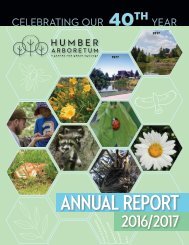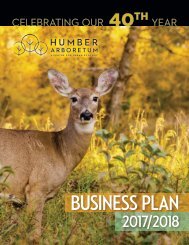Humber Arboretum Business Plan 2018-19
Business Plan from Humber Arboretum, Toronto, Ontario. Canada
Business Plan from Humber Arboretum, Toronto, Ontario. Canada
You also want an ePaper? Increase the reach of your titles
YUMPU automatically turns print PDFs into web optimized ePapers that Google loves.
HUMBER RIVER WATERSHED<br />
history, place &<br />
tri-partnership<br />
Centre for Urban Ecology (CUE)<br />
The Centre for Urban Ecology (CUE) is home to the <strong>Arboretum</strong>’s<br />
educational programs, adult continuing education, camps, community<br />
workshops, and special events. The building is LEED Gold certified,<br />
demonstrating outstanding Leadership in Energy and Environmental<br />
Design. The CUE’s sustainable building features include a green roof,<br />
rainwater collection system, solar awning, and radiant floor heating.<br />
Purpose<br />
<strong>Humber</strong> <strong>Arboretum</strong>'s<br />
purpose is to:<br />
3<br />
• Establish and maintain<br />
a comprehensive, aesthetically<br />
pleasing collection of woody<br />
and herbaceous plants;<br />
• Demonstrate correct arbori-<br />
cultural and horticultural<br />
techniques through responsible<br />
development and maintenance<br />
practices;<br />
• Protect natural areas through<br />
appropriate conservation and<br />
restoration practices;<br />
• Facilitate a range of educational<br />
and research opportunities in<br />
arboriculture and horticulture<br />
and environmental studies;<br />
• Establish and promote the<br />
<strong>Humber</strong> <strong>Arboretum</strong> as a<br />
resource that is an integral<br />
part of the Greater Toronto<br />
community and an attraction<br />
for national and international<br />
visitors;<br />
• Establish, maintain, and<br />
encourage wildlife habitat, and;<br />
• Create and maintain a Centre<br />
for Urban Ecology that will<br />
serve as a gathering point,<br />
with functional laboratory<br />
and classroom facilities.<br />
The 105 hectare <strong>Humber</strong> <strong>Arboretum</strong> is located in Adobigok (Place of the<br />
Alders in the Ojibwe Language). It is situated along the west bend of the<br />
<strong>Humber</strong> River, a Canadian Heritage River 2 . The <strong>Humber</strong> River watershed<br />
spans 903 square kilometres, from the headwaters on the Niagara<br />
Escarpment and Oak Ridges Moraine down through to the river mouth on<br />
Lake Ontario. The watershed historically provided an integral connection<br />
for aboriginal peoples between Ontario’s lakeshore and the Lake Simcoe–<br />
Georgian Bay region. This area is known as the traditional territory of the<br />
Ojibwe Anishnabe aboriginal people and includes several First Nations<br />
communities.<br />
In <strong>19</strong>72, horticultural students from <strong>Humber</strong> College asked to use the<br />
land beside the College’s north campus as a space for experiential<br />
learning. This ultimately led to the creation of the <strong>Humber</strong> <strong>Arboretum</strong><br />
in <strong>19</strong>77 as a joint venture between <strong>Humber</strong> College, Toronto and Region<br />
Conservation, and the City of Toronto 3 . This unique partnership has<br />
created an equally unique organization with the strength of diverse skills,<br />
talents, and knowledge.<br />
Toronto and Region Conservation (TRCA) owns most of the <strong>Arboretum</strong><br />
land and provides environmental expertise and leadership; the City of<br />
Toronto’s Parks, Forestry, and Recreation division provides operational<br />
funding and in–kind services in forestry and horticulture; <strong>Humber</strong> College<br />
owns and operates the venues and structures, offers administrative and<br />
operational oversight, and provides day–to–day staff management.<br />
The <strong>Humber</strong> <strong>Arboretum</strong>’s Tripartite Agreement provides specifications<br />
for strategic leadership and management. The Agreement stipulates that<br />
each of the <strong>Humber</strong> <strong>Arboretum</strong>’s three partners must appoint a member<br />
of senior staff to make up a Management Committee. The Management<br />
Committee is responsible for developing overall policies, strategies,<br />
and protocols to ensure that the <strong>Arboretum</strong>’s purpose is achieved and<br />
maintained. <strong>Humber</strong> College provides a Director of the <strong>Arboretum</strong> to<br />
serve as the day–to–day contact and provide ongoing oversight.<br />
Today the <strong>Humber</strong> <strong>Arboretum</strong> is integrated with <strong>Humber</strong> College’s central<br />
campus in Ward One, Etobicoke North. Its learning gardens sit at the foot<br />
of the College’s student residences.<br />
2<br />
This designation recognizes the <strong>Humber</strong> River's contribution to the development of the country and its<br />
importance in the history of First Nations peoples and early Euro–Canadian explorers and settlers of Upper Canada.<br />
3<br />
The original partnership also included the City of Etobicoke, however, since then the City of Etobicoke has been<br />
amalgamated with the City of Toronto.<br />
Life Zone and Ravine System<br />
The <strong>Humber</strong> <strong>Arboretum</strong> is located within the Carolinian Life Zone 4 .<br />
This is Canada’s most biodiverse ecological region, providing habitat<br />
for approximately 50% of Canada’s birds, 40% of Canada’s native plants,<br />
and 66% of our reptiles. Some 2,200 species of herbaceous plants and<br />
70 species of trees are found in this zone 5 .<br />
It is also Ontario’s most threatened ecological region. The Carolinian Life<br />
Zone encompasses six ecodistricts and the <strong>Humber</strong> <strong>Arboretum</strong> classified<br />
within ecodistrict 7E–4. Under 6% of this ecodistrict remains as natural<br />
forest cover, less than 0.5% is wetland, and its native prairie has been<br />
almost entirely destroyed 6 .<br />
Over 65% of the <strong>Humber</strong> <strong>Arboretum</strong> is located within Toronto’s 45,000–<br />
acre ravine system, a vast interconnected array of forests, rivers and lush<br />
green spaces. This system is gaining increasing international notoriety as<br />
being an iconic landscape feature of Toronto. In 2017, Toronto mayor John<br />
Tory called Toronto's ravines the "physical soul" of the city.<br />
Meadows and Wetlands<br />
Part of the <strong>Humber</strong> <strong>Arboretum</strong> is native meadow. This area is home to<br />
a diverse array of flora and pollinator species. Tucked away in the meadow<br />
is a collection of beehives which have for over two decades provided<br />
delicious small batch honey and served as a point of interest for visiting<br />
students and tour groups. Some of the <strong>Arboretum</strong>’s meadows were<br />
historically wet meadows — a type of wetland with soils that are saturated<br />
for part or all of the growing season. In recent years, TRCA has been<br />
restoring these wetland features to improve water treatment, clean<br />
and slow storm water and floods, and enhance wildlife habitat.<br />
4<br />
CZ; Ecoregion 7E.<br />
5<br />
Source: Carolinian Canada<br />
6<br />
Carolinian Canada and Province of Ontario. (2017). List of the Vascular <strong>Plan</strong>ts of Ontario’s<br />
Carolinian Zone (Ecoregion 7E). (https://www.researchgate.net/profile/Michael_Oldham7/publication/<br />
317731067_List_of_the_Vascular_<strong>Plan</strong>ts_of_Ontario's_Carolinian_Zone_Ecoregion_7E/links/<br />
594b0567aca2723<strong>19</strong>5de8ac8/List-of-the-Vascular-<strong>Plan</strong>ts-of-Ontarios-Carolinian-Zone-Ecoregion-7E.pdf)<br />
4





